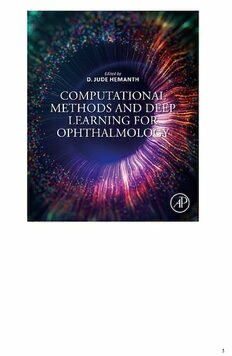Table Of Content1
Computational Methods and Deep Learning for Ophthalmology
Editor
D.Jude Hemanth
Professor, Karunya University, Tamil Nadu, India
2
Table of Contents
Cover image
Title page
Copyright
Contributors
1. Classification of ocular diseases using transfer learning approaches and
glaucoma severity grading
1.1. Introduction
1.2. Literature review
1.3. Proposed methodology
1.4. Results and discussion
1.5. Conclusion
2.Early diagnosis of diabetic retinopathy using deep learning techniques
2.1. Introduction
2.2. Related background
2.3. Experimental methodology
2.4. Proposed flow
2.5. Results and discussion
3
2.6. Conclusion and future direction
3. Comparison of deep CNNs in the identification of DME structural
changes in retinal OCT scans
3.1. Introduction
3.2. Structural changes of DME
3.3. Convolutional neural networks
3.4. Results and discussion
3.5. Conclusion
4. Epidemiological surveillance of blindness using deep learning ap-
proaches
4.1. Conceptualizing surveillance systems in ophthalmic epidemiology
4.2. Deep learning in ophthalmic epidemiological surveillance
4.3. Limitations
4.4. Conclusion
5. Transfer learning-based detection of retina damage from optical coher-
ence tomography images
5.1. Introduction
5.2. Experimental methodology
5.3. Proposed model
4
5.4. Experimental results and observations
5.5. Conclusion
6. An improved approach for classification of glaucoma stages from color
fundus images using Efficientnet-b0 convolutional neural network and
recurrent neural network
6.1. Introduction
6.2. Related work
6.3. Methodology
6.4. Experimental findings
6.5. Conclusion
7. Diagnosis of ophthalmic retinoblastoma tumors using 2.75D CNN seg-
mentation technique
7.1. Introduction
7.2. Literature review
7.3. Materials
7.4. Methodology
7.5. Experimental analysis
7.6. Discussions
7.7. Conclusion
5
8. Fast bilateral filter with unsharp masking for the preprocessing of optical
coherence tomography images—an aid for segmentation and classification
8.1. Introduction
8.2. Methodology
8.3. Results and discussion
8.4. Conclusion
9. Deep learning approaches for the retinal vasculature segmentation in fun-
dus images
9.1. Introduction
9.2. Significance of deep learning
9.3. Convolutional neural network
9.4. Fully convolved neural network
9.5. Retinal blood vessel extraction
9.6. Artery/vein classification
9.7. Summary
10. Grading of diabetic retinopathy using deep learning techniques
10.1. Introduction
10.2. Materials and methods
10.3. Methodology
6
10.4. Results and discussion
10.5. Conclusion
11. Segmentation of blood vessels and identification of lesion in fundus
image by using fractional derivative in fuzzy domain
11.1. Introduction
11.2. Preliminary ideas
11.3. Proposed method of blood vessel extraction
11.4. Proposed method of lesion extraction
11.5. Experimental analysis
11.6. Conclusion
12. U-net autoencoder architectures for retinal blood vessels segmentation
12.1. Introduction
12.2. Related works
12.3. Proposed works
12.4. Experiment
12.5. Conclusion
13. Detection and diagnosis of diseases by feature extraction and analysis on
fundus images using deep learning techniques
13.1. Introduction
7
13.2. Fundus image analysis
13.3. Eye diseases with retinal manifestation
13.4. Diagnosis of glaucoma
13.5. Diagnosis of diabetic retinopathy
13.6. Conclusion
Index
8
Copyright
Academic Press is an imprint of Elsevier
125 London Wall, London EC2Y 5AS, United Kingdom
525 B Street, Suite 1650, San Diego, CA 92101, United States
50 Hampshire Street, 5th Floor, Cambridge, MA 02139, United States
The Boulevard, Langford Lane, Kidlington, Oxford OX5 1GB, United King-
dom
Copyright © 2023 Elsevier Inc. All rights reserved.
No part of this publication may be reproduced or transmitted in any form or
by any means, electronic or mechanical, including photocopying, recording,
or any information storage and retrieval system, without permission in writ-
ing from the publisher. Details on how to seek permission, further infor-
mation about the Publisher’s permissions policies and our arrangements
with organizations such as the Copyright Clearance Center and the Copy-
right Licensing Agency, can be found at our website:
www.elsevier.com/permissions.
This book and the individual contributions contained in it are protected
under copyright by the Publisher (other than as may be noted herein).
Notices
Knowledge and best practice in this field are constantly changing. As
new research and experience broaden our understanding, changes in
research methods, professional practices, or medical treatment may
become necessary.
Practitioners and researchers must always rely on their own expe-
rience and knowledge in evaluating and using any information, meth-
ods, compounds, or experiments described herein. In using such
information or methods they should be mindful of their own safety
and the safety of others, including parties for whom they have a pro-
fessional responsibility.
To the fullest extent of the law, neither the Publisher nor the authors,
contributors, or editors, assume any liability for any injury and/or
damage to persons or property as a matter of products liability,
negligence or otherwise, or from any use or operation of any
9
methods, products, instructions, or ideas contained in the material
herein.
ISBN: 978-0-323-95415-0
For information on all Academic Press publications visit our website
at https://www.elsevier.com/books-and-journals
Publisher: Mara Conner
Acquisitions Editor: Chris Katsaropoulos
Editorial Project Manager: Tom Mearns
Production Project Manager: Prem Kumar Kaliamoorthi
Cover Designer: Christian Bilbow
Typeset by TNQ Technologies
10

